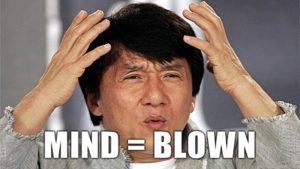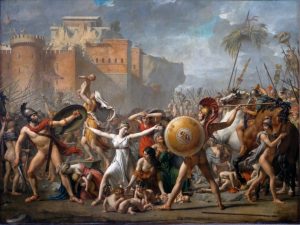Formal analysis is a way of examining and evaluating the aspects of a work of art. Through this, the observer tries to understand the underlying meaning that the artist may have intended for the work of art to have. When formally analyzing a work of art, you must pay attention to components such as color, size and scale, lines, and symbolism. When looking at color, you must pay attention to the types of color schemes and the range used. You must identify whether they are light or dark colors, whether they are primary or secondary colors, and whether the colors contrast with one other depending on their position in the work. When looking at size and scale, you must observe where any subjects or objects in the work are positioned. You also need to note the size of the objects. For example, noting whether the main subject is the largest thing in the work, or if there are things larger than the subject. Lines are a way of identifying the techniques an artist used in a painting. Some parts of a painting may have been painted using stronger strokes or different types of strokes than other parts of a painting. This can perhaps tell how the artist felt about the specific object he was painting. Finally, moving away from the physical aspects, symbolism is a strong component of formal analysis because it allows the observer to understand what the artist intended on saying, without actually saying it. By inserting specific colors, shapes, or objects, the artist can convey a certain emotion, reaction, or thought without having to write or say anything.
Class today (9/17) CANCELLED
Hi all,
I’m sorry for the late notice but i had to go to the hospital this morning and won’t be able to make it to class. I’ll see you all next week!!
We will have a make up something to make up for this cancellation.
Thanks,
Gwen
Gwendolyn Shaw
Formal Analysis

Formal analysis is an explanation of structure in ways which visual elements function with a piece of work. The purest form of formal analysis is defined to what the viewer sees because that’s how the eye looks at art. Visually speaking there are numerous of ideas and images we see off a piece of art. We use different components such as line, shape and form, space, color, and texture to evaluate what the art means. These components break down the significance of what the artist is truly trying to depict. Also, there are different characteristics and concepts in the components that can describe what is happening. Formal analysis can help us understand a piece of art better by asking us questions and thinking about things we usually wouldn’t.
What is Formal Analysis?
Formal Analysis is a form of critiquing an art piece from any era. In other words, this is when someone who writes a description and a study on a piece of art of any form and pinpoints the various areas of attention that the artist (deceased or alive) intended and unintentionally implemented into the piece. The text provides more concrete evidence than most descriptions because it dives deep into the smaller elements of the art. This includes components like line, shape and form, space, color and texture. Through each component, every little bit of the art is broken down and further examined for their purpose in the literal and implicit meanings.
As mentioned, Formal Analysis is composed of various components that build up to a completed conclusion of a piece of art. Of these components, the subsections build each part of the core subject and makes the picture easier to consume by section. Each section compiles different approaches and further breaks down why it was made this way. Works of art are often unique and some artists have a continuity of details they exploit to make each work different yet theirs when it is observed down to the roots. Details like this can be explored much deeper when looking specifically for a class of structures like the way some lines are drawn or painted and the posture of the drawn figure. Hence, it can be said that Formal Analysis strives in the need to observe a work of art down to its core for the most meaning full explanation.

Pedagogy and Power
To Friere, the banking model is described as a knowledge holder sharing knowledge to a knowledge receiver without any feedback from the receiver. This is known as the standard classroom model in which a teacher shares his or her knowledge with students as they feed off that given information. This allows the teachers (knowledge holders) to be empowered because they hold the knowledge that is being given or distributed to the knowledge receivers.
I have had experience with this banking model. When I was younger I used to take karate lessons and when displayed the right techniques my teacher would go forward with the lessons and teach me new moves. By making sure I knew each of these moves before teaching me new ones the teacher allowed me to memorize all of these techniques. Which ultimately lead to me receiving a black belt. The positive aspects of this model of teaching through this experience were that I learned and memorized different moves. However, the negative aspects of this model were that I had to please my teacher through the depiction of the techniques I have learned giving him the power to choose whether or not I could move forward and lean new routines.

Formal Concept Analysis (FCA)
Formal analysis is a convenient catalog of the methodology used to analyze and define art solely based on a work’s inherent qualities. ‘Inherent qualities’ meaning: the creator’s intentions aside, what can be determined about some work of art (primarily visual pieces) from that work. Among the catalog of methodology are–in no particular order–the use (and absence) of color; the solidity of the lines and framework; the conveyance of three-dimensional space or lack thereof; the scale of the visuals.
Formal Analysis
Formal Analysis is a way to specifically describe a piece of art work. It is a representation of how a piece of art is viewed. The viewer evaluates the piece of art through a series of questions such as how the piece came to be, who or what it portrays, when the piece was created, and etc. There are multiple characteristics used when the viewer uses formal analysis to describe and explain a piece of art. Characteristics such as contrast, size/scale, line, color, position, composition, material, illusionism, mimesis, modelling, chiaro/scuro, and depth. The main reason formal analysis is used when evaluating and describing a piece of art is to show the central focus, what is most important about a piece of work, and for the artist to express the painting, drawing or etc. by showing the viewer instead of telling the viewer what goes on in the piece of work. When we say formal analysis it basically means evaluating what the artist left us to view and how this work came to be, historically and physically throughout time. With formal analysis we can conclude what the artist has done based on their piece of work and how that brush stroke or whatever it may be represents what we see and not what we know.
Formal Analysis
As a modern society everyone is exposed to images and pictures in whatever modern device they are using. However people cannot really take in an image and break it down in order to fully understand all its elements that is made out of. In art history the method to analyze an image is called Formal Analysis. Formal Analysis is used to describe a work of art and more than analyzing what the image means, the concept focuses on what elements were used in order to make the work of art. Some of these elements are, composition, tone, colors, lines, depth, lighting, scale, modeling, material, texture and historical context. This elements are helpful when looking at art because it helps the view understand why the artist used them in the first place.

What is Formal Analysis?
What is formal analysis?
Formal Analysis can be defined simple as exploring the visual effects the work has on the viewer and what the artist wanted to accomplish visually. This method focuses primarily on questioning the visual and physical aspect of the artwork. Focusing on lines,shapes,color schemes,texture, form,etc. It’s questioning the work and looking for the answer in the work itself. Formal analysis is the explanation in which, why certain visual effects are arranged and placed in the composition.
What is Formal Analysis?
Formal Analysis is describing visually and emphasizing the formal elements of an art piece and it’s important to note that every little detail has a reason as to why it’s there. Formal analysis affects what the art piece represents. The ‘how’ and the ‘why’ when it comes to art include interpretations on visual evidence which come from formal analysis. Formal analysis is a RE/presentation when it comes to analyzing the formal elements of the art piece.
The properties of formal analysis include:
- Line composition- lines can be horizontal, vertical, straight, curved, thick or thin. This leads our eyes around the composition and show character and direction.
- Texture- (ex. let’s say an art piece has a picture of a man wearing a shirt and you are able to tell the material of the shirt he is wearing)
- Color- neutral or bright colors which can show dullness
- Size/scale
- Modelling- chiaro/scuro (illisionism)
- Material- the tools used
- Contrast
- Position -> composition
- Mimesis, which means realistic
All of these elements bring out the meaning and evaluation of the art work. These components are the artist’s choices, everything is intentional & no detail is insignificant or not worth mentioning ! The bottom line is that the question that formal analysis answers is “What do you see in this piece of art?“






